Original video animation
A two-episode original video animation (OVA) side-story by Studio Fantasia, [29] titled Saikano: Another Love Song, was released on August 5 and September 21, 2005. [30] [31] [32] Viz Media released the OVA on May 9, 2006. [33] In the United Kingdom, the OVA was released by Manga Entertainment on January 29, 2007. [34]
Video game
A video game based on the series, developed by Konami Computer Entertainment Tokyo (KCET) and published by Konami for the PlayStation 2, was released on May 29, 2003. [35]
Live-action film
A live-action film adaptation, directed by Taikan Suga , starring Aki Maeda as Chise and Shunsuke Kubozuka as Shuji, [36] premiered at the Tokyo International Film Festival on October 29, 2005, [37] followed by a theatrical release on January 28, 2006. [38]
Notes
Related Research Articles

Ranma ½ is a Japanese manga series written and illustrated by Rumiko Takahashi. It was serialized in Weekly Shōnen Sunday from August 1987 to March 1996, with the chapters collected in 38 tankōbon volumes by Shogakukan. The story revolves around a teenager named Ranma Saotome who has trained in martial arts since early childhood. As a result of an accident during a training journey, he is cursed to become a girl when exposed to cold water, while hot water changes him back into a boy. Throughout the series Ranma seeks out a way to rid himself of his curse, while his friends, enemies, and many fiancées constantly hinder and interfere.
Rumiko Takahashi is a Japanese manga artist. With a career of several commercially successful works, beginning with Urusei Yatsura in 1978, she is one of Japan's best-known and wealthiest manga artists. Her works are known worldwide, where they have been translated into a variety of languages, with over 230 million copies in circulation; making Takahashi one of the best-selling authors of all time. She has won the Shogakukan Manga Award twice, once in 1980 for Urusei Yatsura and again in 2001 for Inuyasha, and the Seiun Award twice, once in 1987 for Urusei Yatsura and again in 1989 for Mermaid Saga. She also received the Grand Prix de la ville d'Angoulême in 2019, becoming the second woman and second Japanese to win the prize. In 2020, the Japanese government awarded Takahashi the Medal with Purple Ribbon for her contributions to the arts.

Inuyasha is a Japanese manga series written and illustrated by Rumiko Takahashi. It was serialized in Shogakukan's shōnen manga magazine Weekly Shōnen Sunday from November 1996 to June 2008, with its chapters collected in 56 tankōbon volumes. The series begins with Kagome Higurashi, a fifteen-year-old middle school girl from modern-day Tokyo who is transported to the Sengoku period after falling into a well in her family shrine, where she meets the half-dog demon, half-human Inuyasha. After the sacred Shikon Jewel re-emerges from deep inside Kagome's body, she inadvertently shatters it into dozens of fragments that scatter across Japan. Inuyasha and Kagome set out to recover Jewel's fragments, and through their quest, they are joined by the lecherous monk Miroku, the demon slayer Sango, and the fox demon Shippō. Together, they journey to restore the Shikon Jewel before it falls into the hands of the evil half-demon Naraku.
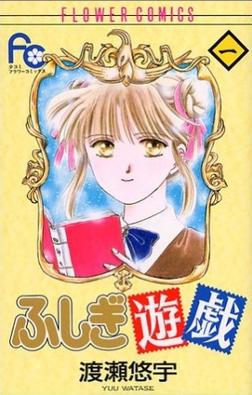
Fushigi Yûgi, also known as Fushigi Yûgi: The Mysterious Play or Curious Play, is a Japanese manga series written and illustrated by Yuu Watase. It tells the story of two teenaged girls, Miaka and Yui, who are pulled into The Universe of the Four Gods, a mysterious book at the National Diet Library. It is based on the four mythological creatures of China. Shogakukan serialized Fushigi Yûgi in Shōjo Comic from December 1991 to May 1996 and later compiled the manga into eighteen tankōbon volumes.
The Prince of Tennis is a Japanese manga series written and illustrated by Takeshi Konomi. The manga was serialized in Shueisha's Weekly Shōnen Jump from July 1999 to March 2008, with its chapters collected in 42 tankōbon volumes. Viz Media licensed the manga for English release in North America.

Project ARMS, simply known in Japan as ARMS, is a Japanese manga series written by Kyoichi Nanatsuki and illustrated by Ryoji Minagawa. It was serialized in Shogakukan's Weekly Shōnen Sunday from March 1997 to April 2002, with its chapters collected in 22 tankōbon volumes. The story follows Ryo Takatsuki, Hayato Shingu, Takeshi Tomoe and Kei Kuruma, four teens who discover that their bodies have been genetically engineered. Despite their differences, they team up and search for answers, leading them to confront an organization called the Egrigori, responsible for the nanomachine technology implanted in their bodies.
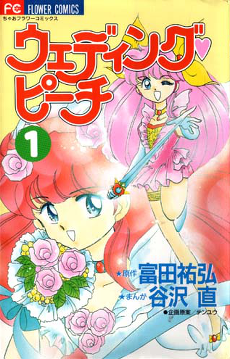
Wedding Peach is a shōjo manga written by Sukehiro Tomita and illustrated by Nao Yazawa that was originally serialized in Shogakukan's Ciao magazine. In North America, it was translated and published by VIZ Media in its entirety, consisting of six volumes.

Cheeky Angel is a Japanese manga series written and illustrated by Hiroyuki Nishimori. It was serialized in Shogakukan's shōnen manga magazine Weekly Shōnen Sunday from June 1999 to August 2003, with its chapters were collected in 20 tankōbon volumes. The story revolves around the adventures of 15-year-old schoolgirl Megumi Amatsuka, a popular and beautiful tomboy that always get into fights with a secret: she used to be a boy.

Mermaid Saga is a Japanese manga series written and illustrated by Rumiko Takahashi. It consists of nine stories told in 16 chapters irregularly published in Shogakukan's Shōnen Sunday Zōkan and Weekly Shōnen Sunday from 1984 to 1994.

Peacock King is a Japanese manga series written and illustrated by Makoto Ogino. It was serialized in Shueisha's seinen manga magazine Weekly Young Jump from 1985 to 1989, with its chapters collected in 17 tankōbon volumes. It spawned four other manga series. The original manga was licensed in North America in 2020 by Manga Planet.
Beast Master is a Japanese shōjo manga series written and illustrated by Kyousuke Motomi. The story follows the relationship between Yuiko, an animal lover, and Leo, a childish young man who has problems adapting because everyone considers him a beast. It was serialized in Shogakukan's Betsucomi magazine from September 2006 to February 2007. Shogakukan later collected the individual chapters into two bound volumes under the Flower Comics imprint. Viz Media licensed the series for an English-language release in North America.

Dorohedoro is a Japanese manga series written and illustrated by Q Hayashida. It was serialized in Shogakukan's manga magazines Monthly Ikki, Hibana, and Monthly Shōnen Sunday ; its chapters were collected in 23 tankōbon volumes. Dorohedoro tells the story of the amnesiac reptilian-headed Caiman, working together with his friend Nikaido to recover his memories and survive in a strange and violent world.

Ikigami: The Ultimate Limit is a Japanese manga series written and illustrated by Motoro Mase. The manga was serialized in Shogakukan's Weekly Young Sunday (2005–2008) and Weekly Big Comic Spirits (2008–2012). A national prosperity law has been passed in a dystopian nation resulting in citizens between the ages of 18 and 24 being randomly selected to die for the good of the nation. These citizens are given 24-hour notification of their impending death. These notifications are known as "ikigami"—the ostensible reason for this system being to help demonstrate the value of life. The manga was adapted into a live-action film titled Ikigami in 2008 with Tomoyuki Takimoto as its director.
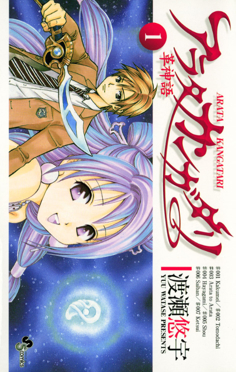
Arata: The Legend is a Japanese manga series written and illustrated by Yuu Watase. It started serialization in Shogakukan's shōnen manga magazine Weekly Shōnen Sunday in October 2008. Its chapters were collected in 24 tankōbon volumes, while a Remaster edition started in July 2013, with 17 volumes published as of May 2023. After a nearly six-year hiatus that began in August 2015, the series resumed publication, with republished chapters in May 2021 and all-new chapters started publishing in July of the same year; the series finished in Weekly Shōnen Sunday in April 2022 and was transferred to the Sunday Webry website in May of the same year. In May 2021, it was announced that the tankōbon edition would stop publishing and the series will only continue with the Remaster edition. The series finished in November 2023. In North America, the manga is licensed for English release by Viz Media. A 12-episode anime television series adaptation by Satelight and Korean studio JM Animation was broadcast on TV Tokyo from April to July 2013.
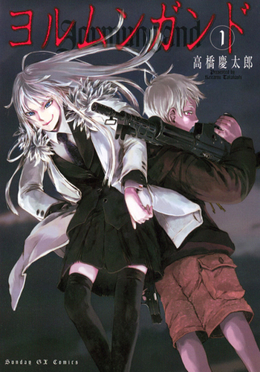
Jormungand is a Japanese manga series written and illustrated by Keitaro Takahashi. It was serialized in Shogakukan's seinen manga magazine Monthly Sunday Gene-X from April 2006 to January 2012, with its chapters collected in eleven tankōbon volumes.

Ichi the Killer is a Japanese manga series written and illustrated by Hideo Yamamoto. A first series, titled Ichi, was serialized in Shogakukan's seinen manga magazine Weekly Young Sunday in 1993; Ichi the Killer was serialized in the same magazine from 1998 to 2001, with its chapters collected in ten tankōbon volumes. The series revolves around Ichi, a psychologically troubled killing machine, and his confrontation with the yakuza of Kabukichō, Shinjuku.
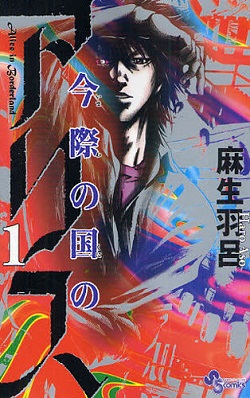
Alice in Borderland is a Japanese suspense manga series written and illustrated by Haro Aso. It was first serialized in Shogakukan's shōnen manga magazine Shōnen Sunday S from November 2010 to March 2015, and later moved to Weekly Shōnen Sunday, where it ran from April 2015 to March 2016. Its chapters were collected in 18 tankōbon volumes. Alice in Borderland was adapted into a three-episode original video animation (OVA), released from October 2014 to February 2015.

Sleepy Princess in the Demon Castle is a Japanese manga series written and illustrated by Kagiji Kumanomata. It has been serialized in Shogakukan's shōnen manga magazine Weekly Shōnen Sunday magazine since May 2016, with its chapters collected in twenty-eight tankōbon volumes as of September 2024. An anime television series adaptation produced by Doga Kobo aired from October to December 2020.

Fly Me to the Moon, also known outside Japan as Tonikawa: Over the Moon for You, is a Japanese manga series written and illustrated by Kenjiro Hata. It has been serialized in Shogakukan's shōnen manga magazine Weekly Shōnen Sunday since February 2018, with its chapters collected in 30 tankōbon volumes as of December 2024. The story centers around the teenage genius Nasa Yuzaki and his developing relationship with his new wife, Tsukasa, who saves him from a traffic accident during the beginning of the story. In North America, the manga is licensed by Viz Media.
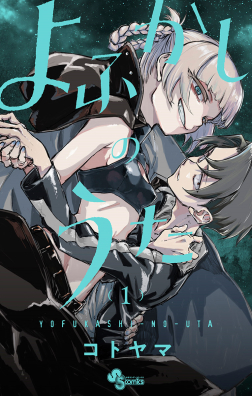
Call of the Night is a Japanese manga series written and illustrated by Kotoyama. It was serialized in Shogakukan's shōnen manga magazine Weekly Shōnen Sunday from August 2019 to January 2024. In North America, the manga is licensed for English release by Viz Media. An anime television series adaptation produced by Liden Films aired from July to September 2022 on Fuji TV's Noitamina programming block. A second season has been announced.
References
- 1 2 "She, The Ultimate Weapon". Sentai Filmworks. Archived from the original on November 11, 2018. Retrieved November 11, 2018.
- 1 2 Dungan, Mike (February 5, 2005). "Saikano (aka: Saishuu-heiki Kanojo) Vol. #03". Mania.com. Archived from the original on October 5, 2012. Retrieved January 7, 2020.
Takahashi's combination of high school romance and war drama is a surprisingly good fit.
- ↑ 経験すると成長する!?漫画家・高橋しん氏の作品が2冊同時発売に!! (in Japanese). Shogakukan. September 30, 2019. Archived from the original on October 24, 2021. Retrieved October 24, 2021.
- ↑ 週刊ビッグコミックスピリッツ 2001年(平成13年)48 (in Japanese). Mandarake Inc. Archived from the original on March 10, 2023. Retrieved March 10, 2023.
- ↑ WEEKLYビッグコミックスピリッツ2001年48号詳細情報. manganetto.com (in Japanese). Archived from the original on March 13, 2023. Retrieved March 13, 2023.
- ↑ 最終兵器彼女. s-book.com (in Japanese). Shogakukan. Archived from the original on October 2, 2008. Retrieved October 24, 2021.
- ↑ Macdonald, Christopher (December 1, 2005). "New Saikano Short Story". Anime News Network (in Japanese). Archived from the original on October 24, 2021. Retrieved October 24, 2021.
- ↑ 世界の果てには君と二人で / 最終兵器彼女外伝集. s-book.com (in Japanese). Shogakukan. Archived from the original on August 6, 2006. Retrieved October 24, 2021.
- ↑ 最終兵器彼女 愛蔵版 第1集 (in Japanese). Shogakukan. June 28, 2016. Archived from the original on October 24, 2021. Retrieved October 24, 2021.
- ↑ 最終兵器彼女 愛蔵版 第4集 (in Japanese). Shogakukan. June 28, 2016. Archived from the original on October 24, 2021. Retrieved October 24, 2021.
- 1 2 Mays, Jonathan (October 30, 2003). "Viz announces SaiKano anime, manga". Anime News Network . Archived from the original on October 24, 2021. Retrieved October 24, 2021.
- ↑ "Saikano, Volume 1". Viz Media. Archived from the original on March 30, 2013. Retrieved October 24, 2021.
- ↑ "Saikano, Volume 7". Viz Media. Archived from the original on March 30, 2013. Retrieved October 24, 2021.
- ↑ "About SAIKANO". saikano-usa.com. Archived from the original on January 7, 2010. Retrieved October 24, 2021.
- 1 2 3 最終兵器彼女. Media Arts Database (in Japanese). Agency for Cultural Affairs. Archived from the original on October 24, 2021. Retrieved October 24, 2021.
- ↑ 「最終兵器彼女」BD-BOX発売!スリーブは高橋しん描き下ろし、新規座談会も収録. Natalie (in Japanese). Natasha, Inc. June 14, 2018. Archived from the original on October 24, 2021. Retrieved October 24, 2021.
- ↑ Cruz, Luis (April 28, 2004). "Saikano Vol. #1 (of 0)". AnimeOnDVD. Archived from the original on August 26, 2004. Retrieved October 24, 2021.
- ↑ Cruz, Luis (November 17, 2004). "Saikano Vol. #1 (of 0)". AnimeOnDVD. Archived from the original on March 8, 2005. Retrieved October 24, 2021.
- ↑ "Saikano (DVD Box Set)". Viz Media. Archived from the original on December 23, 2010. Retrieved October 24, 2021.
- ↑ Ressler, Karen (December 17, 2014). "Sentai Filmworks Adds Saikano/She, The Ultimate Weapon". Anime News Network . Archived from the original on October 24, 2021. Retrieved October 24, 2021.
- ↑ Ressler, Karen (April 7, 2015). "North American Anime, Manga Releases, April 5–11". Anime News Network . Archived from the original on October 24, 2021. Retrieved October 24, 2021.
- ↑ "She, The Ultimate Weapon (Season 1) Complete Collection". Sentai Filmworks. Archived from the original on October 24, 2021. Retrieved October 24, 2021.
- ↑ Mateo, Alex (October 26, 2021). "North American Anime, Manga Releases, October 24–30". Anime News Network . Retrieved July 29, 2022.
- ↑ Morton, Bryan (May 11, 2006). "She, The Ultimate Weapon Vol. #1". Mania.com. Archived from the original on February 23, 2009. Retrieved October 24, 2021.
- ↑ Morton, Bryan (August 10, 2006). "She, The Ultimate Weapon Vol. #3". Mania.com. Archived from the original on May 17, 2009. Retrieved October 24, 2021.
- ↑ "She, the Ultimate Weapon V1 - Girlfriend". Madman Entertainment. Archived from the original on September 15, 2006. Retrieved October 24, 2021.
- ↑ "She, the Ultimate Weapon V4". Madman Entertainment. Archived from the original on September 15, 2006. Retrieved October 24, 2021.
- ↑ "She, the Ultimate Weapon Collection". Madman Entertainment. Archived from the original on May 16, 2008. Retrieved October 24, 2021.
- ↑ 大人気を博したTVシリーズ全13話とOVA全2話をコンプリートしたBlu-rayがお求めになりやすい新価格になって登場! (in Japanese). Toei Video. June 4, 2021. Archived from the original on October 24, 2021. Retrieved October 24, 2021.
- ↑ Macdonald, Christopher (March 10, 2005). "Saikano Trailer". Anime News Network . Archived from the original on October 24, 2021. Retrieved October 24, 2021.
- ↑ 最終兵器彼女 MISSION.1. Media Arts Database (in Japanese). Agency for Cultural Affairs. Archived from the original on October 24, 2021. Retrieved October 24, 2021.
- ↑ 最終兵器彼女 Another love song MISSON:2. Media Arts Database (in Japanese). Agency for Cultural Affairs. Archived from the original on October 24, 2021. Retrieved October 24, 2021.
- ↑ "Saikano OVA (DVD)". Viz Media. Archived from the original on December 23, 2010. Retrieved October 24, 2021.
- ↑ Morton, Bryan (December 13, 2006). "She, The Ultimate Weapon: Another Love Song OVA". Mania.com. Archived from the original on May 17, 2009. Retrieved October 24, 2021.
- ↑ 最終兵器彼女. Media Arts Database (in Japanese). Agency for Cultural Affairs. Archived from the original on November 24, 2023. Retrieved November 24, 2023.
- ↑ Macdonald, Christopher (May 17, 2005). "Aki Maeda in Saikano Movie". Anime News Network . Archived from the original on February 25, 2021. Retrieved October 24, 2021.
- ↑ Macdonald, Christopher (September 23, 2005). "Saikano Live-Action". Anime News Network . Archived from the original on October 24, 2021. Retrieved October 24, 2021.
- ↑ 最終兵器彼女 THE LAST LOVE SONG ON THIS LITTLE PLANET (in Japanese). Toei Animation. Archived from the original on January 11, 2013. Retrieved October 24, 2021.
External links
- Official manga website at Viz Media at the Wayback Machine (archived 2010-01-19)
- Official anime website at Gonzo at the Wayback Machine (archived 2005-03-06)(in Japanese)
- Official anime website at Gonzo at the Wayback Machine (archived 2005-02-11)(in English)
- Official anime website at Sentai Filmworks
- Official anime website at Gonzo at the Wayback Machine (archived 2005-03-06)(in Japanese)
- Official video game website at Konami at the Wayback Machine (archived 2005-11-18)(in Japanese)
- Saikano (manga) at Anime News Network 's encyclopedia
| Saikano | |
 First tankōbon volume cover, featuring Chise | |
| 最終兵器彼女 (Saishū Heiki Kanojo) | |
|---|---|
| Genre | |
Works by Shin Takahashi | |
|---|---|
|